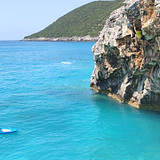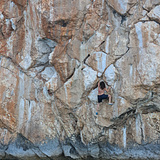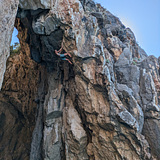Near the sport climbing area of Gjipe, which is worth visiting in its own right, there is collection of cliffs above the sea that hold a lot of potential for deep water soloing.
These topos are an overview of the established lines we know of, as well as info on how to get to the cliffs.
SAFETY
Most lines have seen very few ascents, so info might be off. Always check the depth for yourself! Depth can change quickly as blocks fall in to the water due to erosion.
Remember that you are quite far from help and have a plan on how to help someone out of the water if need be.
If you're new to deep water soloing read up or ask a friend with more experience about good safety practices and how to fall properly.
Tides in Albania are very small, with the water level usually varying less than 30 cm between high and low tide. This means we haven't found it to be a factor yet with any of the climbing we've done so far.
During peak season, in July and August, in recent year there is a large number of boats offering tours with people visiting different beaches and caves.
During this season consider climbing on the walls in between, that are of n interest to the tour boats. If you do decide to climb in the caves, at least be mindful of the other boats, if you're not on the wall, make space for them to look at the cave as they usually stay for only a minute. If someone is on the wall make sure to communicate to avoid having boats below the climber.
Every route in this topo has been given a safety (S) rating based on the system commonly used for deep water soloing. The ratings we gave are based on the definition used by Mike Robinson in 'Deep Water (2007). They have been adapted to not include tidal info as those are not relevant here. Below a quick description of what to expect at a given S-grade. For most routes that have a specific risk we will also detail it in the description of the route.
* S0: safe water depth and a clear path if you fall. No particularly high crux moves. Routes with this grade are relatively safe to climb, you can climb until you fall.
* S1: Care required. The water depth might be such that there is potential for touching the bottom softly if you pencil. Alternatively there might be cruxy moves high up.
* S2: A little more care than S1 required. Landings can be more complicated. This could mean a shallow landing where you need to slow yourself down so you don’t hit the bottom, or this could mean having to push off the wall a bit when falling to avoid lower angle terrain or rocks that stick out. These routes are likely to have a high crux.
* S3: Expect the water to be either too shallow or too far away! Falling in an uncontrolled way is not really an option on routes with these grades. The hard moves might be extremely high above the water, and/or landing safely might require aiming for a specific spot in the water for sufficient depth/no obstructions.



